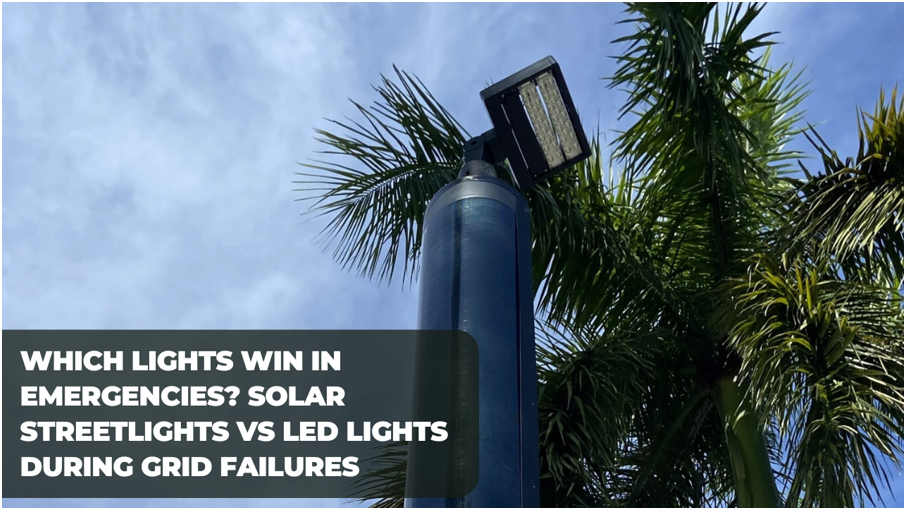When disaster strikes—be it a hurricane, wildfire, or unexpected blackout—communities need more than just emergency alerts and first responders. They need continuity, clarity, and visibility. In these high-stress situations, street lighting becomes a crucial asset, offering direction, enhancing public safety, and supporting coordinated relief efforts. Yet too often, this silent guardian is one of the first casualties when the grid goes down.
This brings us to the ongoing conversation around Solar Streetlights vs LED Lights and their respective roles in disaster resilience. While both lighting technologies are energy-efficient and commonly used in urban environments, there’s a critical difference in how they respond when the central power grid fails. For emergency operations directors and disaster planners, understanding this distinction is vital when designing lighting infrastructure that protects communities when they need it most.
The Fragility of Grid-Dependent LED Lighting
LED lights have become widely adopted for their impressive energy efficiency and extended lifespan, making them a popular choice for municipalities aiming to modernize their infrastructure. They offer significant savings over traditional lighting and require less frequent replacement. However, a major limitation remains: their reliance on the electrical grid. In emergencies such as storms, blackouts, or natural disasters, this dependence becomes a liability. Without grid power, even the most advanced and efficient LED lights fail to function, leaving public areas dark and vulnerable.
This grid dependency creates vulnerabilities during:
- Hurricanes and severe storms that down power lines
- Wildfires that threaten critical infrastructure
- Earthquakes and floods that disrupt utility networks
- Rolling blackouts due to demand surges or cyberattacks
When lighting fails during emergencies, the consequences go beyond inconvenience:
- First responders may struggle to navigate darkened roads and evacuation zones
- Public panic can increase in unlit, unsafe areas
- Crime rates may rise as shadows deepen in already vulnerable neighborhoods
Solar Streetlights: Built to Withstand the Worst
Unlike their grid-tied counterparts, solar-powered streetlights operate independently of utility lines. Each unit typically includes solar panels, an integrated battery pack, and smart lighting controls—all contained within the pole itself. This means even when the grid goes dark, the lights stay on.
Why solar streetlights excel in emergencies:
- Off-grid independence: They don’t rely on external power, making them ideal for critical infrastructure.
- Battery backup: Stored solar energy ensures operation through the night, even during multi-day outages.
- Resilient hardware: Designed to withstand harsh weather and environmental stress.
Smart controls: Systems can adapt lighting levels and alert operators to maintenance needs in real-time.
From maintaining visibility along evacuation routes to keeping transit hubs, hospitals, and shelters lit during blackouts, solar streetlights have proven to be invaluable assets in disaster scenarios.
Case in Point: Lighting That Endures When the Grid Doesn’t
Several municipalities across storm-prone regions have already seen the benefits firsthand. In coastal cities impacted by hurricanes, solar lighting systems have continued to operate while entire neighborhoods remained dark. These installations have ensured:
- Safe navigation for emergency vehicles
- Constant lighting for temporary medical stations
- Safer pedestrian environments during extended outages
- Reduced deployment of portable lighting, freeing resources for other needs
Beyond the Outage: Calculating the Resilience Dividend
While LED lighting may seem like a cheaper upgrade at first glance, it carries hidden costs in grid reliance and vulnerability during blackouts. Solar streetlights, on the other hand, represent a long-term investment in both sustainability and reliability. When factoring in maintenance savings, operational continuity, and avoided emergency costs, solar systems often outperform traditional lighting models over time.
Where Should Resilient Lighting Be Prioritized?
Emergency operations planners should consider solar lighting for:
- Evacuation routes and transportation corridors
- Fire-prone zones and earthquake fault lines
- Low-income or underserved areas prone to prolonged outages
- Parks, campuses, and event zones used as emergency shelters
Conclusion: When the Lights Go Out, the Choice Is Clear
In the debate of Solar Streetlights vs LED Lights, efficiency is only one piece of the puzzle. The real test comes during a crisis, when visibility, public safety, and emergency coordination are on the line. For resilience planners, solar-powered streetlights offer a future-proof solution that functions regardless of grid status. When disaster strikes, these lights don’t just shine, they save lives.
Read More: Tesla Stock in 2025: Is TSLA Still a Good Investment?
